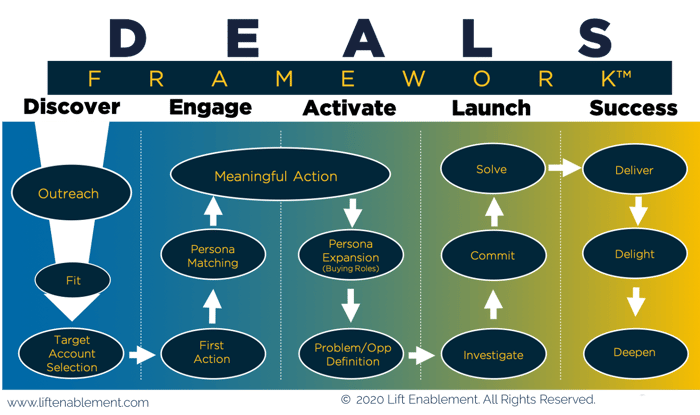 You have a bunch of target contacts visiting your website. They’re reading your blog, checking out some videos, looking at product/service pages, and maybe even filling out a form.
You have a bunch of target contacts visiting your website. They’re reading your blog, checking out some videos, looking at product/service pages, and maybe even filling out a form.
That’s all great, but how do you know whether all of that activity and engagement is progressing to increase the likelihood of creating a new customer? What signals do you look for to know that the context and actions of your sales and marketing approach should change?
It’s difficult to pinpoint when a target account shifts in their journey from curious to actively engaged. Identifying various signals for this change provides insight that increases your velocity.
In The DEALS Framework™ we call that signal a meaningful action.
The DEALS Framework Revisited
The DEALS Framework works as a roadmap to combine all aspects of what your company does to find, win and retain high-valued customers. It unifies the different methodologies, strategies, and tactics that you’re already implementing. To get a better idea of what this framework looks like, here’s an image for anyone who enjoys visuals.

As shown in the image, meaningful action is placed towards the center of the framework. Before you address meaningful actions, you need to work through the Discover Stage and the Engage Stage. In these stages, your sales, marketing, and customer success teams are working to find/reach out to the people that fit your product/service. They’re also working to get those target contacts to take a first action. The Activate Stage and the Launch and Success Stages come after meaningful actions. The goal of the Activate Stage is to influence how the contact thinks about their problems and the opportunities they have. The Launch and Success Stages are your active sales process and your customer success/retention. In these stages, you’re finalizing/closing deals and making sure your customers are successful and happy.
When it comes down to meaningful actions, think of them as a bridge. Not only do they bridge the Engage Stage to the Activate Stage, they bridge a shift in mindset. When a meaningful action takes place, this is a confirmable signal that the contact is no longer in a passive seeking mode, but in an active searching mode. At this point, there is a conscious, active awareness of the company and/or product/service that is being offered. Meaningful actions enable you to personalize, contextualize, and customize your plan of action. Use what you learn from contacts who have taken an action to initiate and stimulate the next contact. Doing so will increase the likelihood that the next contact connects and takes the desired action.
3 Attributes to Every Meaningful Action Event
Meaningful actions are highly contextual. They need to connect to your strategy and advantages that you offer. Because of this, every company is going to end up tracking something different. To make defining a meaningful action easier, there are 3 attributes that every event should include.
1. The action is confirmable. This is pretty self explanatory. A meaningful action has taken place when you can confirm there has been some action taken. If you can't show an action has taken place, it can not be meaningful.
2. The action connects to a key insight pillar. A key insight pillar lays out a realization potential clients must have in order to realize that the status quo is hindering their progress. A Key insight pillar lays out the groundwork for your message and frames your argument around a specific topic. This key insight pillar is frame-breaking. It opens up the mind of your prospects to reframe their perspective to align with your approach.
3. The content on the page viewed delivers a Point-of-View (POV). POV insights are frame-breaking insights that change how the person you’re communicating with thinks about their situation. They change the target’s mindset and upend the status quo. This goes hand-in-hand with the insight pillar — think of point 2 and point 3 of being a package deal. These points are important because in order for the contact to realize they need your product/service, some change of mindset has to take place.
Examples of Meaningful Action
What exactly does a meaningful action look like? Having a target contact visit one blog on your site isn’t enough. (Unless that blog is identified as having in-depth content that pertains to a POV/pillar insight.) When it comes to defining meaningful actions for your company, ask yourself: "What would someone have to do on my site for them to come across as interested in my product/service?" This could include:
- Attending a webinar
- Reading an in-depth blog series
- Registering and attending a workshop
- Exploring detailed web pages on your product/service (This can include your pricing page if you have one.)
- Subscribing and interacting with gated content
- And more
There are many possibilities to choose from as long as what you track is confirmable, connects to a key insight pillar, and delivers a POV. To go further, here are a few examples of meaningful actions from companies we’ve worked with before.
1. A SaaS company defined one of their meaningful actions as when a targeted persona had visited their website at least 4 times, read 2 different blog posts (this counted towards visiting their website 4 times), and had visited their pricing page.
2. A consulting company defined their meaningful action when one of their defined personas visited their approach page and filled out a form for one of their industry-specific white papers or self-assessments.
For us at Lift, we’ve been tracking specific pages as meaningful actions. We’ve cataloged a selection of deep resource web pages and videos that match up to our various personas. When a defined persona gets to a certain part of a page or crosses a time threshold with one of those assets, we can confirm they’ve taken a meaningful action.
Defining meaningful actions for your company is challenging, especially if you’ve never done this before. Once you’ve identified what you're looking for, capturing target contacts who have taken those actions gets easier. Remember, if what you define isn’t cutting it, revisit the process and adjust. You’ll find what works for you. When you do, you’re one step closer to successfully winning more sales.

